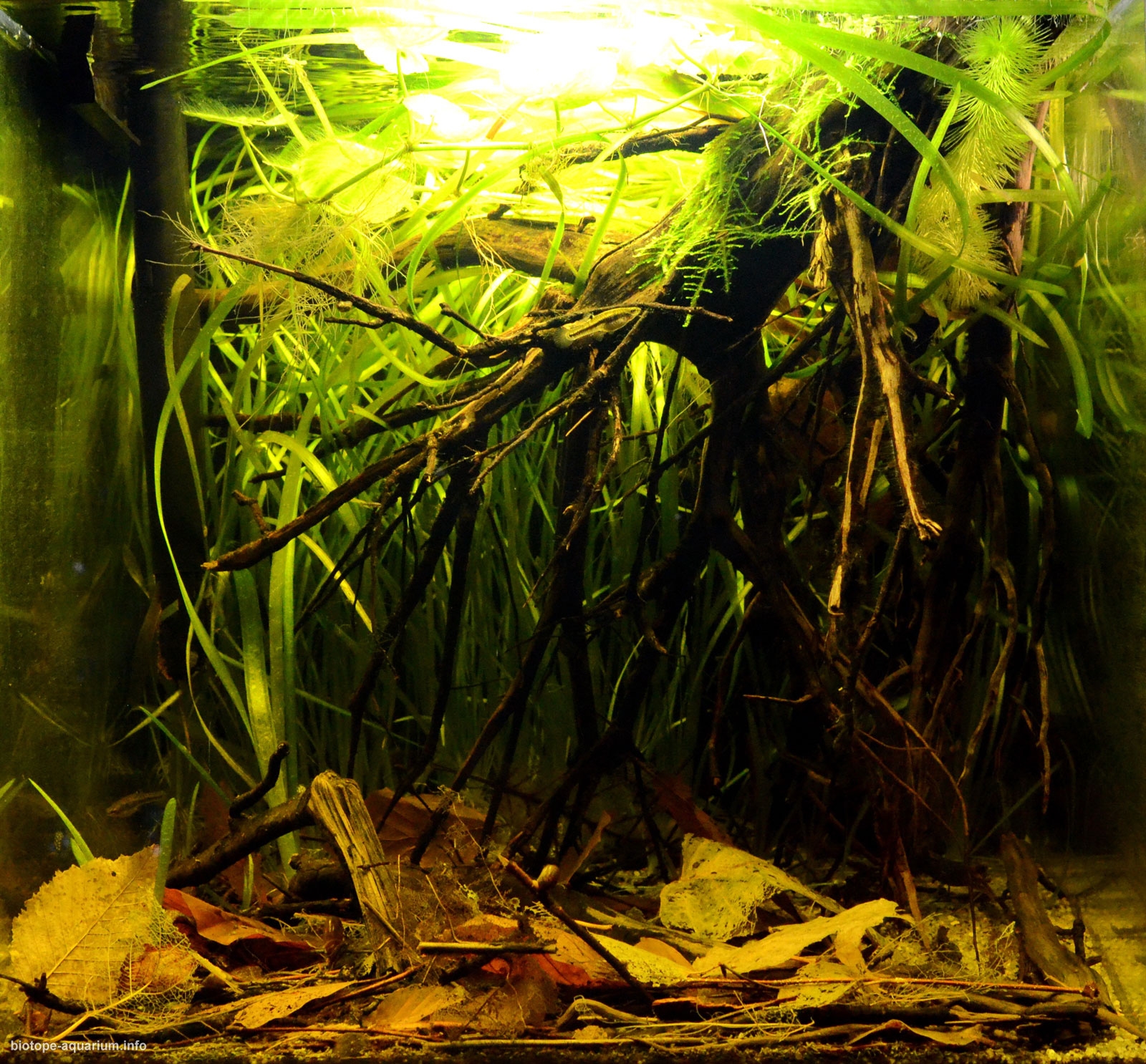Small stream in Choctaw National Wildlife Refuge, Alabama, USA
56th place in Biotope Aquarium Design Contest 2017
![]() Poland. Dominik Woroch
Poland. Dominik Woroch

Volume: 42 L
Dimensions: 35x35x35 cm
List of fishes: Heterandria formosa, Cambarellus diminutus
List of plants: Vallisneria spiralis L, Hydrocotyle leucocephala, Ceratophyllum demersum, Lemna minor, Taxiphyllum sp.
Description of decorations: I used a root that, thanks to its shape, fits perfectly into the biotope. At the bottom I scattered the sand of different gradations, and a large amount of leaves and branches.
Description of equipment: Aquael VERSAMAX, Chihiros A LED A-351
Water parameters: Temperature is 23°C, pH is 7,7, gH is 15.
Description of the area surrounding the biotope: The Choctaw National Wildlife Refuge is located in southwest Alabama along the Tombigbee River approximately 80 miles north of Mobile. The Refuge was established in 1964 on lands acquired by the Corp of Engineers in conjunction with the Coffeeville Lock and Dam project. The 4,218 acre refuge encompasses approximately 1,802 acres of lakes, sloughs, and creeks, 2,265 acres of bottomland hardwoods, and 151 acres of croplands and moist soil units. The main river reserve is the Tombigbee River. The Tombigbee River is a tributary of the Mobile River, approximately 325 km long, in the U.S. states of Mississippi and Alabama. These waters, and the hardwood bottomlands and open fields around them, draw a wealth of wildlife species, from American alligators to Anhingas. Refuge managers provide habitat and protection for threatened and endangered species, like the Wood Stork and Bald Eagle, and promote wildlife diversity, wildlife-dependent recreation, habitat for wintering waterfowl, and Wood Duck production and bandin.
Description of the underwater landscape of the biotope: The stream flows mainly through heavily wooded areas, so the bottom is littered with fallen leaves, branches and roots. The amount of biological mass is very high. The substrate is muddy, the stones are unlikely to occur.
Description of the parameters of the habitat: Water not transparent, temperature from 5 degrees in winter to 26 degrees in summer. Ph varies between 6.8 and 8.1. TDS is high.
List of fishes: Ictalurus furcatus, Micropterus salmoides, Acipenser oxyrhynchus desotoi, Etheostoma nuchale, Moxostoma duquesnii, Heterandria formosa,
Cyprinella callistia, Percina sciera, Semotilus thoreauianus, Cambarellus Diminutus, Elassoma evergladei.
List of plants: Vallisneria spiralis L, Echinodorus Cordifolius, Hydrocotyle leucocephala, Cabomba caroliniana, Myriophyllum Spicatum, Ceratophyllum demersum, Myriophyllum Verticillatum, Hydrocotyle Verticillata, Sagittaria Platyphylla, Lemna minor, Taxiphyllum sp., Ludwigia repens, Bacopa monnieri.
Sources of information:
- https://www.fws.gov/choctaw/,
- https://en.wikipedia.org/wiki/
Choctaw_National_Wildlife_Refu ge, - https://en.wikipedia.org/wiki/
Tombigbee_River, - https://waterdata.usgs.gov/nwi
s/uv/?site_no=02469100, - http://www.adem.alabama.gov/pr
ograms/water/wqsurvey/2001Inte nsiveWQSTombigbee.pdf, - http://www.encyclopediaofalaba
ma.org/article/h-1586, - http://fishbase.org, http://www.tropicos.org
Comments of the members of the jury of Biotope Aquarium Design Contest 2017
At the first glance this tank looks really simple: just a root, some Vallisneria, and some decaying leaves on the bottom. But in my opinion all these “simple” components are very well balanced, animals have lots of hiding places (crayfish penetrating the space under one of the leaves, first picking the leaf up – priceless sight!), fast growing plants probably remove all the organic waste, and bottom is covered with dead leaves in various stages of decomposition.

Again, in this entry it is not clear that this is a part of a river system. The current is not simulated with the help of camouflaged pumps; it is not clear from which perspective the composition is set up. It looks more like a swampy area with standing water.
